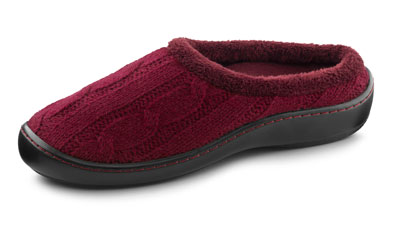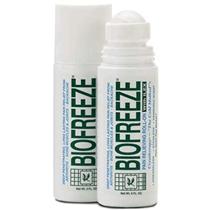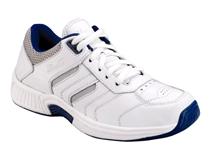Causes and Treatment of Top of Foot Pain
Pain on the top of the foot can be caused by many problems and the discomfort can range from mildly uncomfortable to quite painful depending on the cause. If you notice swelling and pain on the top of your forefoot this may be due to a stress fracture and you should contact us for an appointment in our Seattle clinic.
Home Treatments for Top of Foot Pain
If you are not in the Seattle area and want to try home treatments first, you can find our recommended home treatments for top of foot pain below.
Video: How to Treat Top of Foot Pain
The most common causes of pain on top of the feet are:
- Dorsal compression syndrome (pressure between the joints on top of the foot)
- Arthritis
- Stress fracture
- Nerve entrapment or irritation
Common symptoms of pain on top of the foot include:
- Aching of the top of the foot without swelling (indicates dorsal compression syndrome or arthritis)
- Swelling and pain on your forefoot (indicates a possible stress fracture)
- Swelling and discomfort (may indicate arthritis)
- Tingling that extends towards your toes (may indicate nerve irritation)
Since these conditions often require different therapies, the best way to ensure your top of foot pain is properly treated is to first obtain an accurate diagnosis. If the top of your foot hurts, contact the Foot and Ankle Center of Washington for an immediate appointment. On your first visit, we will diagnose your top of foot problems through a review of your medical history, a physical exam of your foot and, if required, we will take x-rays. We can usually relieve your pain using conservative methods. Surgery is almost never necessary.
If you are not in the Seattle area and wish to try home treatment first, our recommended self-treatments for pain on the top of the foot can be found below.
Dorsal Compression Syndrome
This is a common cause of top of foot pain and occurs when the foot flattens out too much. The foot is an arch. When an arch collapses, the arch gets longer on the bottom and shorter on the top. So, as the foot flattens, the arch gets shorter on the top of the foot which causes pressure between the bones and pain on the top of your foot.
To treat dorsal compression syndrome, we must reduce pressure between the bones on top of the foot. To do this, we must stop the arch from collapsing. The most effective method is to use an orthotic that conforms very closely to the arch of the foot called a total contact orthotic. If the arch of the orthotic gaps away from the arch of the foot, then the orthotic will not effectively reduce the pressure or your pain. Click here for more information on why our orthotics work better for top of foot pain.
Stress Fractures on Top of the Foot
A stress fracture of a metatarsal bone or tarsal bone can cause pain on the top of your foot. Click here for detailed information on stress fractures.
Midfoot Arthritis
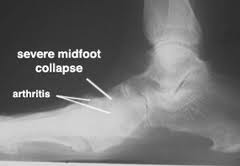 Foot arthritis between the bones on the top of your feet can also lead to pain. Midfoot arthritis, simply put, is damage to the joints in the middle of your foot. You can see in the x-ray that the joints have worn away. Common causes of midfoot arthritis include:
Foot arthritis between the bones on the top of your feet can also lead to pain. Midfoot arthritis, simply put, is damage to the joints in the middle of your foot. You can see in the x-ray that the joints have worn away. Common causes of midfoot arthritis include:
- Flat foot
- Carrying excess weight
- Trauma (broken bone or bad sprain)
Flat foot and obesity are the most common causes of this type of arthritis – they both force the foot to flatten which forces the bones on the top of the foot together. Over time, this increased pressure damages the joints. To eliminate the pain, we have to support the foot and decrease or eliminate motion of the damaged joints.
This can be done with the use of a very specific type of foot orthotic, shoe changes and modifications or through surgical fusion of the joints of the midfoot. Surgery should only be considered as a very last resort. Midfoot arthritis should be treated professionally so we can protect your joints now to stop or slow further joint damage.
One of the most effective treatments is a total contact custom orthotic that conforms extremely closely to the arch to reduce midfoot motion and decrease pain. Motion causes pain in arthritic joints. Limiting motion can limit pain. Prefabricated orthotics won’t provide enough support to protect joints because they gap away from the arch and allow it to flatten. This increases pain by allowing too much motion.
In addition to total contact orthotics, other treatments for arthritis of the top of the foot include ankle foot orthotics and rocker shoes. Surgery is also a possibility but should be considered only as a last resort. If, however, you wish to try to treat this yourself, click here for suggested best self- treatments for midfoot arthritis.
Proper Midfoot Arthritis and Top of Foot Pain Orthotics
An effective orthotic must be made from a laser scan or foot cast taken with the foot not bearing any weight at all. If the doctor allows the foot to bear weight while the image is taken, the force will cause the arch to flatten so the orthotic made from this cast will not conform closely to the arch of the foot.
Click to learn more about how your foot should be casted for orthotics.
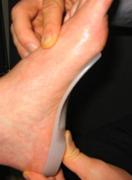
Total contact orthotic
Your doctor should take the laser scan or cast of your foot, not an assistant. Proper positioning of the foot is critical to the best outcome. If they assign an assistant to cast your foot, cancel the appointment.
In order to limit motion in the painful joints at the top of the foot, the orthotic must conform very close to the arch of the foot. This is called a total contact orthotic.
Also, the podiatrist must write an effective and specific orthotic prescription that tells the orthotic lab how to make the orthotic in a manner that limits the motion of the arthritic joints in your feet.
Finally, the doctor must use a very high quality orthotic lab. Some labs are good but, unfortunately, there are many labs with poor standards. Many orthotics are made with arches that are excessively flat and these devices will not do a good job of limiting painful foot motion.
Treating Top of Foot Pain Conservatively and Avoiding Surgery
In the case of dorsal compression, when the foot flattens as you step, the bones on top of the foot compress together which causes pain. The first goal in treating this pain is to limit flattening of the arch so the bones won’t compress against each other. Proper arch supports (in the form of custom orthotics) and proper footwear design help drastically.
Also, avoid going barefoot – even around the house. We may also recommend topical pain relievers and icing. If you take this advice and follow our home treatment plan below, you should experience relief within a week or two if you have dorsal compression. Even if you have foot arthritis, these changes should help bring some pain relief.
Self-Treatment Plan to Relieve Top of Foot Pain
Before you start this home therapy plan for pain on the top of your foot, you should make sure you do not have a stress fracture. Forefoot pain with swelling are symptoms of stress fracture. We recommend you follow this plan for three weeks. Most people will see relief within the first week or two. If your pain isn’t gone after three weeks, contact us to discuss other treatment alternatives. The products below are the ones we recommend to our patients and they are also affiliate links so we may receive a small commission at no additional cost to you if your order from the link
1. Use an arch support in your shoes
Use an arch support that matches your arch as close as possible. The closer the arch support conforms to the arch of your foot the better it 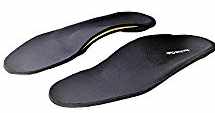 will be at decreasing pressure between the joints on top of your foot.
will be at decreasing pressure between the joints on top of your foot.
We recommend supports with higher arches and some rigidity.
The best OTC support we have found for top of foot pain and foot arthritis is the FootChair Orthotic with adjustable arch height because it is semi- rigid and has a relatively high arch, and most importantly, the arch can be adjusted.
The FootChair is the only arch support on the market that comes with pads that allow the arch to be adjusted to ensure you are getting the best support and pain relief. By adding more pads and increasing the arch height you can find the arch height that gives you the balance between relief of symptoms and comfort.
For smaller shoes including flats, high heels and soccer cleats we recommend the FootChair Slim Orthotic with adjustable arch height. 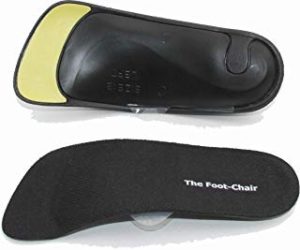 It has the same excellent adjustable arch as the full size FootChair but in a much slimmer profile. It also flexes to fit many heel heights.
It has the same excellent adjustable arch as the full size FootChair but in a much slimmer profile. It also flexes to fit many heel heights.
2. Use a flip-flop, slipper or sandal with srch support at home
Walking around barefoot allows arch collapse that increases pressure between the bones on top of the foot. We recommend you wear slippers or sandals with an arch support while at home.
Vionic sandals, slippers and flop-flops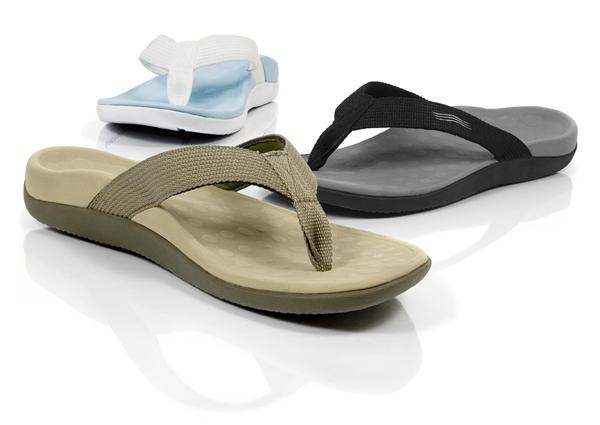 provide outstanding arch support and are perfect for anyone prone to foot problems such as heel pain, ball-of-foot pain, big toe joint pain, tendonitis and overall tired feet. These healthy sandal options combines orthotic treatment and comfort in stylish and sporty sandals. Click here to browse all Vionic flip-flops, sandals and Slippers
provide outstanding arch support and are perfect for anyone prone to foot problems such as heel pain, ball-of-foot pain, big toe joint pain, tendonitis and overall tired feet. These healthy sandal options combines orthotic treatment and comfort in stylish and sporty sandals. Click here to browse all Vionic flip-flops, sandals and Slippers
3. Ice the foot
Daily icing can also help top of foot pain. At the end of the day, elevate your foot and ice it for 10 minutes each evening. This can reduce pain and swelling caused by arthritis, dorsal compression or injuries.
4. Topical pain relief
Non-prescription topical analgesics offer relief for many top of foot pain patients. We recommend Biofreeze Cold Therapy Relief which provides relief in a couple of different ways. The cold sensation can help address pain and the glucosamine and other ingredients work together to help achieve pain relief in some cases. This gel is well-reviewed, particularly among those with arthritis.
5. Choose stable shoes and add an exceptional arch support
- Stability – A stable shoe will support your foot and keep it from flattening. Shoes should have a firm heel and torsional (anti-twisting) stability. This prevents the
 heels from rolling inward and the foot from flattening too much, which leads to bones compression. Orthofeet Shoes for Women and Orthofeet Shoes for Men are some of our favorites.
heels from rolling inward and the foot from flattening too much, which leads to bones compression. Orthofeet Shoes for Women and Orthofeet Shoes for Men are some of our favorites.
- Deeper Than Average Shoes – Shoe depth makes a difference because it reduces pressure on the top of the foot. Orthofeet Shoes for Women and Orthofeet Shoes for Men are all constructed to be deeper while still looking fairly stylish.
Don’t live with pain on the top of your foot. Contact us today to make an appointment in our convenient Seattle office on First Hill near Swedish Medical. Call 206-344-3808 or go here to online schedule an appointment with our expert podiatrists for fast and effective relief of your top of foot pain no matter the cause.
Medical References for Top of Foot pain and Midfoot Arthritis
Halstead, J, et. al. “Foot orthoses in the treatment of symptomatic midfoot osteoarthritis using clinical and biomechanical outcomes: a randomised feasibility study”. Clin Rheumatol. 2015 Apr 28
S Rao, “Shoe inserts alter plantar loading and function in patients with midfoot arthritis,” Journal of Orthopaedic & Sports Physical Therapy, (2009).
S Rao, JF Baumhauer, et al, “Orthoses alter in vivo segmental foot kinematics during walking in patients with midfoot arthritis,” Archives of Physical Medicine and Rehabilitation, (2001).
A Ibuki, A Cornoiu, A Clarke, “The effect of orthotic treatment on midfoot osteoarthritis assessed using specifically designed patient evaluation questionnaires,” Prosthetics and Orthotics International, (2010).
S Rao, JF Baumhauer, et al, “Comparison of in vivo segmental foot motion during walking and step descent in patients with midfoot arthritis and matched asymptomatic control subjects,” Journal of Biomechanics, (2009).
S Walmsley, M Ravey, et al, “Development of a patient-reported outcome measure for the foot affected by rheumatoid arthritis,” Journal of Clinical Epidemiology, (2012).
J Riskowski, AB Dufour, MT Hannan, “Arthritis, foot pain and shoe wear: current musculoskeletal research on feet,” Current Opinion in Rheumatology, (2011).
